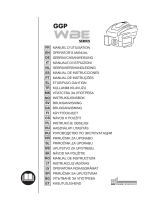
2
Safety
Training
1. Read the instructions carefully. Be familiar with
the controls and the proper use of the equipment.
2. Never allow children or people unfamiliar with
these instructions to use the lawnmower. Local
regulations may restrict the age of the operator.
3. Never mow while people, especially children, or
pets are nearby.
4. Keep in mind that the operator or user is
responsible for accidents or hazards occurring to
other people or their property.
Preparation
1. While mowing, always wear substantial
footwear and long trousers. Do not operate the
equipment when barefoot or wearing open
sandals.
2. Thoroughly inspect the area where the
equipment is to be used and remove all objects
which may be thrown by the machine.
3. WARNING – Petrol is highly flammable.
• Store fuel in containers specifically
designed for this purpose.
• Refuel outdoors only and do not smoke
while refuelling.
• Add fuel before starting the engine. Never
remove the cap of the fuel tank or add
petrol while the engine is running or when
the engine is hot.
• If petrol is spilled, do not attempt to start
the engine but move the machine away
from the are of spillage and avoid creating
any source of ignition until petrol vapors
have dissipated.
• Replace all fuel tanks and container caps
securely.
4. Replace faulty silencers.
5. Before using, always visually inspect to see that
the blades, blade bolts and cutter assembly are
not worn or damaged. Replace worn or damaged
blades and bolts in sets to preserve balance.
6. On multi–bladed machines, take care as rotating
one blade can cause other blades to rotate.
Operation
1. Do not operate the engine in a confined space
where dangerous carbon monoxide fumes can
collect.
2. Mow only in daylight or in good artificial light.
3. Avoid operating the equipment in wet grass,
where feasible.
4. Always be sure of your footing on slopes.
5. Walk, never run.
6. For wheeled rotary machines, mow across the
face of slopes, never up and down.
7. Exercise extreme caution when changing
direction on slopes.
8. Do not mow excessively steep slopes.
9. Use extreme caution when reversing or pulling
the lawnmower towards you.
10. Stop the blade(s) if the lawnmower has to be
tilted for transportation when crossing surfaces
other than grass, and when transporting the
lawnmower to and from the area to be mowed.
11. Never operate the lawnmower with defective
guards, shields or without safety protective
devices in place.
12. Do not change the engine governor settings or
overspeed the engine.





















